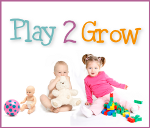For the next couple of weeks, I’ll be posting the critter care sensory tubs that I made. Keep in mind that these are for preschool age children or older. I think younger kids would put this stuff in their mouth and even though the stuff is fresh out of the packages, I wouldn’t feel comfortable giving some of these materials to them.
I’ll start off with a hamster care tub.
What’s in the tub:
Aspen shavings as the base,
Hamster food,
Bowl,
Water bottle,
ABC blocks,
Chew sticks,
TV,
Strawberry,
Two hamsters,
Exercise wheel,
And a measuring cup for scooping and pouring.
The tub is actually a critter pet carrier. The shavings are aspen with no other kinds of wood mixed in as I mentioned above. We use these for all our critters here at home. We don’t have hamsters at the moment, but we have in the passed and these shavings worked well for them. The shavings are mostly soft wood but you’ll occasionally find some harder wood chips. It’s a little dusty though, but it’s a material that you can scoop, pour and burry things in.
The biggest thing in the tub is the exercise wheel. It’s in the tub for the first picture for demonstration, but I took it out for the rest of the pictures. If I were putting this in a larger sensory table, I’d add my extra wheel which is the same size.
The bowl is actually for a hamster and the food is hamster or gerbil food. We have two gerbils so this is the kind of food I used. The bottle is the perfect size for hamsters or gerbils as well. I didn’t fill it because wet shavings can make a huge mess, but it has a little plastic fish inside which would normally tell you how much water you have left in the bottle.
The TV and strawberry are of course for hamsters to sleep. Since hamsters spend three fourths of the day sleeping, they need hideouts. I thought the TV and strawberry were cute. Unfortunately, these hamsters were too big, but I wanted to show normal sized sleeping quarters for hamsters. Other ideas for hideouts are the bottom part of a milk gallon container with a door cut out of it, tissue boxes or paper bags.

I included a bunch of ABC blocks because hamsters need plenty of wood to chew on. Since their teeth keep growing, chewing on the wood helps file their teeth down. I also included some chew sticks to show what hamster treats look like. Hamsters can be given some fresh fruits and veggies. We used to give ours a grape or piece of carrot for a treat. They also sell a variety of treats for hamsters at the pet stores.
The two plush hamsters are made by Aurora. I’d prefer plastic animals that way the shavings don’t get stuck to them, but you can just pick the shavings off the fur. Also, I wanted to note that in real life, there should never be more than one hamster to a cage unless they are dwarf hamsters. For our playing purposes, we can have as many hamsters as we’d like. Hamsters make better pets for older children, but some of you have children of different ages in your family. This is a way for little ones to experience hamsters without the worries of dropping the hamster, getting bit or overfeeding it.
We were going to do something similar to this at the preschool last summer, but like a lot of plans there, they get scrapped. However, I thought it was still worth including on the blog because kids love pets and I thought it would be useful for them to get introduced to the materials necessary to care for them. It’s important to teach children about responsible pet ownership.
ASPCA Hamster Care
Hamster Coloring Pages
Tuesday, January 25, 2011
hamster Care Sensory Tub
Subscribe to:
Post Comments (Atom)


Very cute! Love this idea! We have a real hampster in the classroom and this would be a great way for them to apply what they have learned from our real hamster!
ReplyDeleteoh my goodness, this is just TOO cute! :)
ReplyDeleteWhat a great sensory bin!!! So fun :-)
ReplyDeleteThank you for all the nice comments.
ReplyDelete